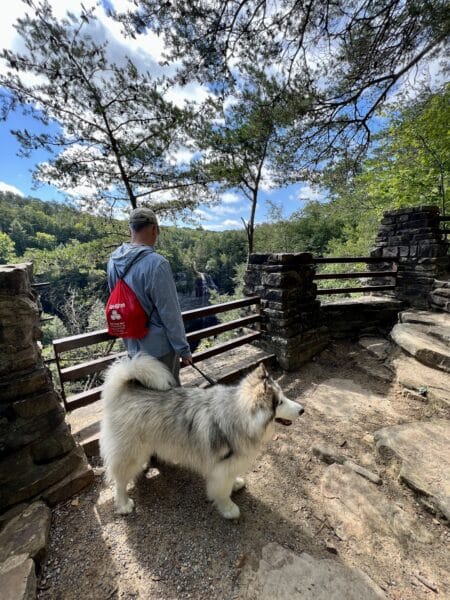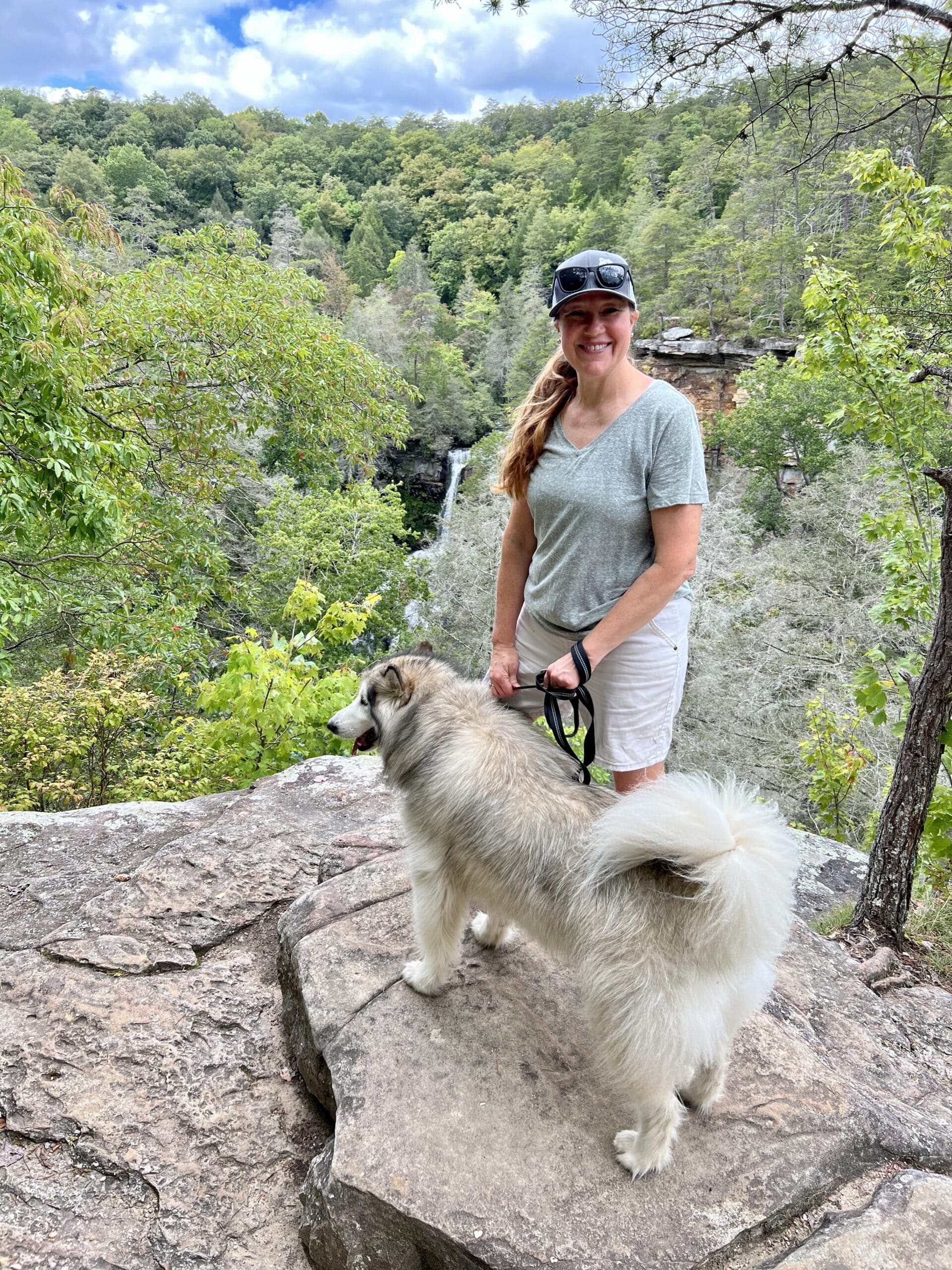Do you love the great outdoors, hiking, camping and traveling with your pup? Let’s talk about the different ways to enjoy America’s most beautiful natural places and spaces with your dog. National parks are managed by the federal government. There are more than 400 parks in the National Park System, preserving some of America’s most famous, beloved, precious, historic and natural wonders across the country. Examples include the Great Smoky Mountains National Park, which is the country’s most-visited national park, Yellowstone National Park, the Vietnam Veterans’ Memorial and other monuments along the National Mall in Washington, D.C.
State parks, managed by individual state governments, feature many equally stunning landscapes and natural areas. Local parks are also fun green spaces owned and operated by cities, counties or towns. One of the most famous examples may be New York City’s Central Park, which allows dogs in most areas, provided they’re on a leash, between 9 a.m. and 9 p.m.
The 10 most dog-friendly national parks
Amy Burkert’s is founder of GoPetFriendly.com and author of “The Ultimate Pet Friendly Road Trip: A Guide to the #1 Pet Friendly Attraction in 48 States & Washington D.C.” Nine of the 10 dog-friendly national park suggestions come from Amy’s travel experience. We’ve linked to each specific park’s B.A.R.K Ranger or dog policies.
The 10 most dog-friendly national parks:
- Acadia National Park, Maine
- Grand Canyon National Park, Arizona
- National Mall, Washington, D.C.
- Shenandoah National Park, Virginia
- Congaree National Park, South Carolina
- Cuyahoga Valley National Park, Ohio
- Padre Island National Seashore, Texas
- Petrified Forest National Park, Arizona
- Wrangell-St. Elias National Park and Preserve, Alaska
- Gettysburg National Military Park (GNMP), Pennsylvania
Why visit a dog-friendly national park?
People are drawn to parks for many reasons — travel and vacations, a love of nature and the great outdoors, plus fun recreation such as hiking, swimming, camping and more. And according to TripAdvisor, 53% of pet parents worldwide bring their pets while traveling!
But before you blaze just any trail with Buster, do your research. Before heading to a national or state park, make sure you can answer these questions:
- Does this park allow dogs?
- What rules are in place for dogs and dog owners to follow?
- Do I have the necessary gear and supplies to make sure my dog stays safe?
- What type of wildlife can I expect to see and how does that affect my dog?
How your dog can become a B.A.R.K Ranger
Many of the national parks have B.A.R.K Ranger programs. It’s a pretty simple concept that welcomes pets into the parks. Basically, when families pledge to follow the four rules, then complete park activities such as pet-friendly hikes, they often earn a certificate or keepsake from that park and some pretty cool swag to boot.
B.A.R.K stands for four key concepts:
Bag your pet’s poop.
Always keep your pet on a leash.
Respect wildlife.
Know where you can go.

Even if a national park is mostly pet-friendly, there are bound to be specific trails, beaches, waterways and other areas that are off-limits to dogs. This is often for your pet’s own safety to avoid treacherous areas such as hot springs and dangerous rocks, or to protect wildlife or waterways that supply drinking water, says Kathy Grant, supervisory park ranger at Acadia National Park in Maine.
Dog-friendly national parks in Maine: Acadia National Park
Acadia, says Kathy, was one of the early adopters of the NPS B.A.R.K Ranger program, and since launching the program in 2016, it has advised many other national parks on how to add B.A.R.K Ranger programs too.
Visitors with dogs should make Acadia’s visitor center their first stop, Kathy recommends, because a ranger can explain which areas of the park are most pet-friendly. That information is also on Acadia’s website. Pup tent, anyone? Camping with dogs is allowed at Acadia. And with 150 miles of trails, Acadia’s hiking is one of the most popular dog-friendly activities.
Specific dog-friendly trails, recommended by Kathy, include:
- Ocean paths such as Great Head Trail
- The 45 miles of Carriage Roads
- The iconic Jordan Pond Path
There are two national parks that stand out in Amy Burkert’s memory as especially dog-friendly — Acadia and the Grand Canyon. Amy recommends Acadia for the wide variety of trails, coupled with Maine’s spectacular seaside scenery.
Dog-friendly national parks in Pennsylvania
The reasons we include Gettysburg? In addition to its significance in American history, its dog-friendly 33 miles of trails and more than 1,300 monuments and markers make it the largest collection of outdoor sculptures in the world — including two very special dog-related sculptures!
The Irish Brigade Monument is considered one of the prettiest monuments at Gettysburg, says Jason Martz of GNMP. It’s topped with a large Celtic cross and has a life size Irish Wolfhound sculpted at its base.
The monument to the 11th Pennsylvania Volunteer Infantry Regiment includes Sallie, a bronze Terrier — a brindle-coated Staffordshire Bull Terrier to be exact. Sallie was given to the regiment as a puppy, and she took part in every one of the regiment’s Civil War battles. Jason says she was such a good girl that following the Battle of Gettysburg, as the story goes, Sallie was found with some of the regiment’s dead and dying soldiers until the living discovered her two days later.
I also have to put a plug in for my home state and its outstanding state park system — one of the largest in the country that offers free admission to all. Although I’ve camped and hiked at many, one of our recent favorites is Black Moshannon State Park, near Penn State University, where we enjoyed some very unique hikes including the Bog Trail’s boardwalk with Luna.
Dog friendly hiking in South Dakota
During her cross-country travels, Amy says one of the most dog friendly state parks she visited was Custer State Park in South Dakota. There are miles of trails, and she describes pretty pine needle-covered paths along the creek. Wildlife is plentiful, including buffalo, so Amy recommends checking at the visitor center to ask where the herd is active before hiking with your dog. Buffalo generally don’t like dogs, and your dog’s behavior could be unpredictable when encountering one — or more — for the first time, even from a distance. So, Amy recommends attaching bear bells to dog collars. Putting that jingle-jangle into your pup’s step is sure to bring smiles, as well as safety, over the miles.
Dog-friendly hiking in Tennessee
I recently traveled to Tennessee with my husband and our Alaskan Malamute, Luna. We all loved the adventure of hiking to the base and numerous gorgeous vistas of Fall Creek Falls, the highest free flowing waterfall east of the Rockies. From a dog-friendly campground as our home base, we hiked to all four major waterfalls within Fall Creek Falls State Park, and Luna even trotted across two suspension bridges with us.
Hiking in national forests
Visiting national parks during peak season can take a lot longer than anticipated, Amy says, and can leave you and your dog frustrated. However, many national forests, often located adjacent to national parks, are pet friendly! And many offer similar vistas and scenery, but without the traffic and crowds.
Amy recommends hiking in the Dixie National Forest, located between Bryce Canyon and Zion National Parks in Utah. Ultimately, she says, national forests offer an off-the-beaten-path nature experience. And what could be better than a little solitude with your furry soul mate?






